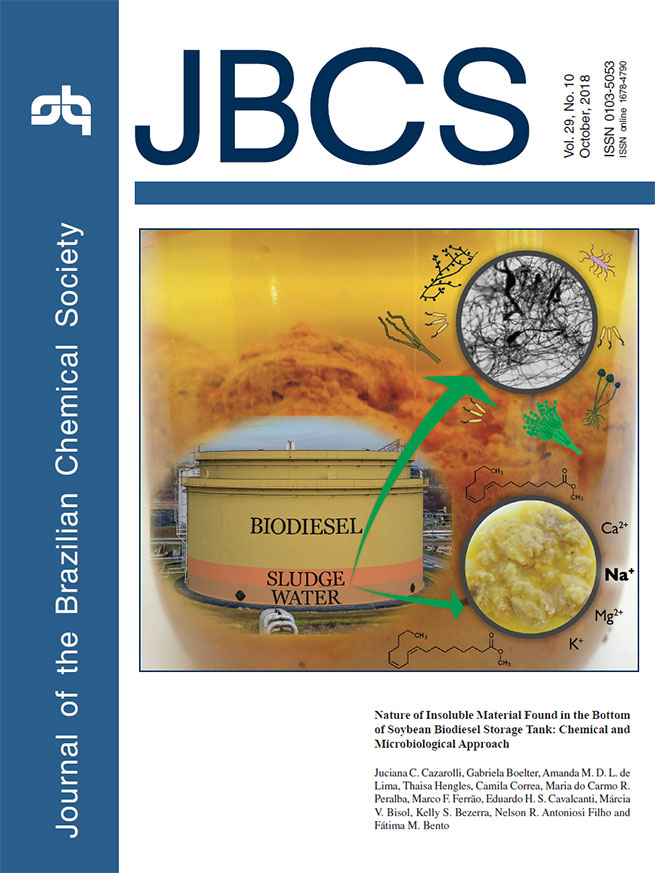vol. 29, No. 10, 2018, p. 1981-2212
Biodiesel can leave industry along with contaminants from production system. A sediment present in the bottom of biodiesel storage tanks of pure soybean was evaluated and fatty acids esters, metal ions and a microbial community were detected. The species found were already described as deteriogenics, however, according to the conditions established during 60 days growth evaluation, the microorganisms did not exhibit biodiesel degradation potential. Details are presented in the Article Nature of Insoluble Material Found in the Bottom of Soybean Biodiesel Storage Tank: Chemical and Microbiological Approach by Juciana C. Cazarolli, Gabriela Boelter, Amanda M. D. L. de Lima, Thaisa Hengles, Camila Correa, Maria do Carmo R. Peralba, Marco F. Ferrao, Eduardo H. S. Cavalcanti, Márcia V. Bisol, Kelly S. Bezerra, Nelson R. Antoniosi Filho and Fátima M. Bento on page 2034.
Nature of Insoluble Material Found in the Bottom of Soybean Biodiesel Storage Tank: Chemical and Microbiological Approach
Juciana C. Cazarolli; Gabriela Boelter; Amanda M. D. L. de Lima; Thaisa Hengles; Camila Correa; Maria C. R. Peralba; Marco F. Ferrao; Eduardo H. S. Cavalcanti; Márcia V. Bisol; Kelly S. Bezerra; Nelson R. Antoniosi Filho; Fátima M. Bento
How to cite this article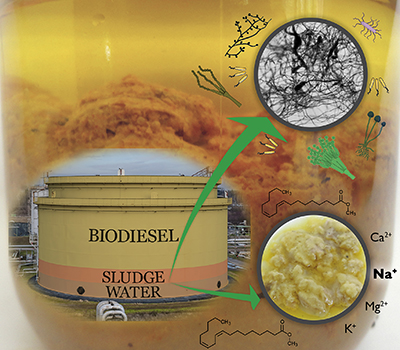
Biodiesel can leave industry along with contaminants from production system. A sediment present in the bottom of biodiesel storage tanks of pure soybean was evaluated and fatty acids esters, metal ions and a microbial community were detected. The species found were already described as deteriogenics, however, according to the conditions established during 60 days growth evaluation, the microorganisms did not exhibit biodiesel degradation potential. Details are presented in the Article Nature of Insoluble Material Found in the Bottom of Soybean Biodiesel Storage Tank: Chemical and Microbiological Approach by Juciana C. Cazarolli, Gabriela Boelter, Amanda M. D. L. de Lima, Thaisa Hengles, Camila Correa, Maria do Carmo R. Peralba, Marco F. Ferrao, Eduardo H. S. Cavalcanti, Márcia V. Bisol, Kelly S. Bezerra, Nelson R. Antoniosi Filho and Fátima M. Bento on page 2034.
https://dx.doi.org/10.21577/0103-5053.20180078
Editorial J. Braz. Chem. Soc. 2018, 29(10), 1981-1982
It is Necessary to React
Aldo José Gorgatti Zarbin
How to cite this article
https://dx.doi.org/10.21577/0103-5053.20180164
Review J. Braz. Chem. Soc. 2018, 29(10), 1983-1998
Insights into Protein-Ionic Liquid Interactions Aiming at Macromolecule Delivery Systems
Liliam K. Harada; Jorge F. B. Pereira; Welida F. Campos; Erica C. Silva; Carla G. Moutinho; Marta M. D. C. Vila; José M. Oliveira Jr.; José A. Teixeira; Victor M. Balcao; Matthieu Tubino
How to cite this article

Potential for application of ionic liquids in biomimetic drug delivery systems, due to their high compatibility with enzymes and other proteins, promotion of higher selectivities, faster reaction rates and greater enzyme stabilities in biocatalytic reactions, and providing a path for the structural and functional stabilization of protein entities.
https://dx.doi.org/10.21577/0103-5053.20180141
J. Braz. Chem. Soc. 2018, 29(10), 1999-2025
Deep Eutectic Solvents as Unconventional Media for Multicomponent Reactions
Luiz S. Longo Jr.; Marcus V. Craveiro
How to cite this article
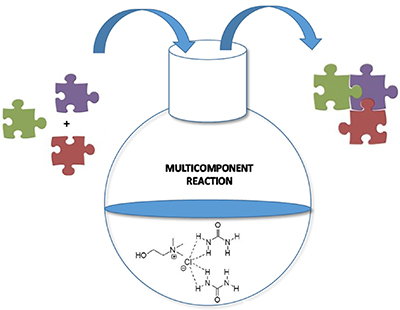
This review article describes the use of deep eutectic solvents (DES) as both solvent and/or catalyst in multicomponent reactions.
https://dx.doi.org/10.21577/0103-5053.20180147
Articles J. Braz. Chem. Soc. 2018, 29(10), 2026-2033
Synergism in the Antibacterial Action of Ternary Mixtures Involving Silver Nanoparticles, Chitosan and Antibiotics
Marcelo S. L. Brasil; Aline L. Filgueiras; Marina B. Campos; Mariana S. L. Neves; Mateus Eugênio; Lídia A. Sena; Celso B. Sant'Anna; Vânia L. da Silva; Cláudio G. Diniz; Antonio C. Sant'Ana
How to cite this article
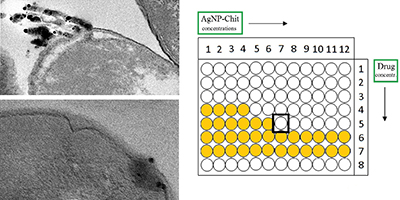
The combined antimicrobial action of the ternary mixture of silver nanoparticles, chitosan and antibiotics against four bacterial strains proved synergic. The pH conditions for the biological assays were carefully defined to exclude the acid effect in the antimicrobial action, preserving chitosan solubility.
https://dx.doi.org/10.21577/0103-5053.20180077
J. Braz. Chem. Soc. 2018, 29(10), 2034-2045
Nature of Insoluble Material Found in the Bottom of Soybean Biodiesel Storage Tank: Chemical and Microbiological Approach
Juciana C. Cazarolli; Gabriela Boelter; Amanda M. D. L. de Lima; Thaisa Hengles; Camila Correa; Maria C. R. Peralba; Marco F. Ferrao; Eduardo H. S. Cavalcanti; Márcia V. Bisol; Kelly S. Bezerra; Nelson R. Antoniosi Filho; Fátima M. Bento
How to cite this article
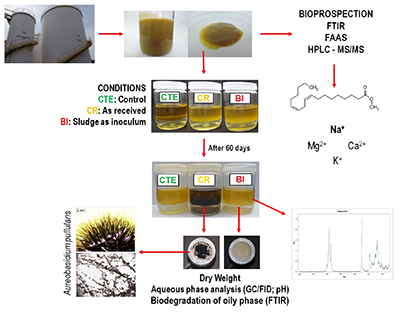
Sediment from the bottom of biodiesel storage tanks was characterized by chemical and microbiological techniques. Fatty acids esters and metal ions were detected, as well as bacteria and fungi, which after 60 days in incubation did not exhibit biodiesel deteriogenic potential.
https://dx.doi.org/10.21577/0103-5053.20180078
J. Braz. Chem. Soc. 2018, 29(10), 2046-2053
Determination of 4-Nonylphenol in Surface Waters of the Guandu River Basin by High Performance Liquid Chromatography with Ultraviolet Detection
Frederico G. de Araujo; Glauco F. Bauerfeldt; Yara P. Cid
How to cite this article

Solid-phase extraction and liquid chromatography coupled with an ultraviolet detector were used for the detection and quantification of 4-nonylphenol in samples of surface water collected in the basin of the Guandu River.
https://dx.doi.org/10.21577/0103-5053.20180079
J. Braz. Chem. Soc. 2018, 29(10), 2054-2059
Electrical Immunosensor Made with Antigenic Peptide NS5A‑1 Immobilized onto Silk Fibroin for Diagnosing Hepatitis C
Lais R. Lima; Alem-Mar B. Gonçalves; Fernando V. Paulovich; Osvaldo N. Oliveira Jr.; Sidney J. L. Ribeiro; Marli L. Moraes
How to cite this article

Electrical response of the immunosensor solutions containing the specific antibody anti-hepatitis C virus (HCV) could be clearly distinguished and for unspecific antibody anti-human immunodeficiency virus (HIV) no significant change has been observed.
https://dx.doi.org/10.21577/0103-5053.20180080
J. Braz. Chem. Soc. 2018, 29(10), 2060-2071
Synthesis and Characterization of Newly Fused 1,2-Dihydropyrido[3,4-b], Bridged Oxadiazol-2-yl, 4-Substituted-benzylidene Hydrazide and Arylidene 6-Chloroquinoxaline 1,4-Dioxides
Samy B. Said; Fawzia Z. El-Ablack; Hani M. Elbeheiry
How to cite this article

Some new unexpected arylidene and fused heterocyclic 6-chloroquinoxaline 1,4-dioxide are synthesized from the precursor 6-chloro-3-(ethoxycarbonyl)-2-methylquinoxaline 1,4-dioxide.
https://dx.doi.org/10.21577/0103-5053.20180081
J. Braz. Chem. Soc. 2018, 29(10), 2072-2088
Physicochemical Characterization of a Crude Anthocyanin Extract from the Fruits of Jussara (Euterpe edulis Martius): Potential for Food and Pharmaceutical Applications
Laura I. L. Favaro; Victor M. Balcao; Liliam K. H. Rocha; Erica C. Silva; José M. Oliveira Jr; Marta M. D. C. Vila; Matthieu Tubino
How to cite this article
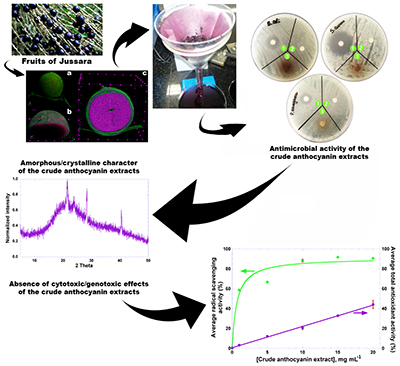
Anthocyanins are attracting the interest of researchers and industry due to potential as a coloring agent and beneficial effects for health. The crude anthocyanin extract produced exhibited slight antimicrobial activity against Staphylococcus aureus, strong antioxidant activity and generalized amorphous behavior.
https://dx.doi.org/10.21577/0103-5053.20180082
J. Braz. Chem. Soc. 2018, 29(10), 2089-2095
Extraction and Characterization of Passion Fruit and Guava Oils from Industrial Residual Seeds and Their Application as Biofuels
Osvaldo K. Iha; Guilherme B. C. Martins; Erick Ehlert; Mateus A. Montenegro; Renata R. Sucupira; Paulo A. Z. Suarez
How to cite this article
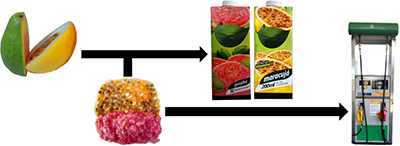
Guava and passion fruit waste generated by the juice industry were taken and treated to obtain the seed oils, which were characterized and used to produce biofuels.
https://dx.doi.org/10.21577/0103-5053.20180083
J. Braz. Chem. Soc. 2018, 29(10), 2096-2103
Amperometric Electrochemical Platform for Hydrazine Determination Exploiting Reduced Graphene Oxide, Co(Salophen) and DNA: Application in Pharmaceutical Formulations Samples
Ludymila V. Freitas; Kayni C. M. S. Lima; Saimon M. Silva; Fernando R. F. Leite; Ridvan N. Fernandes; Wallans T. P. Santos; Flavio S. Damos; Rita C. S. Luz
How to cite this article
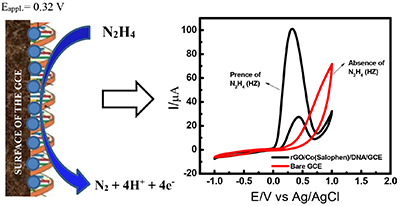
Oxidation of hydrazine on the rGO/Co(Salophen)DNA modified electrode and cyclic voltammograms for the oxidation of hydrazine on the unmodified glassy carbon electrode (red voltammogram) and rGO/Co(Salophen)DNA modified glassy carbon electrode.
https://dx.doi.org/10.21577/0103-5053.20180084
J. Braz. Chem. Soc. 2018, 29(10), 2104-2116
Binary Solvent Dispersive Liquid-Liquid Microextraction for the Determination of Pesticides in Natural Water Samples
Priscila L. S. Estevao; Patricio Peralta-Zamora; Noemi Nagata
How to cite this article
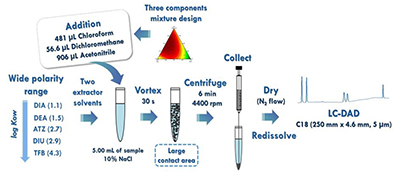
The binary solvent dispersive liquid-liquid microextraction was used for the simultaneous quantification of pesticides with a broad polarity range.
https://dx.doi.org/10.21577/0103-5053.20180085
J. Braz. Chem. Soc. 2018, 29(10), 2117-2126
Evaluation of the Suitability of Analytical Methods in Trichothecene A and B Degradation
Ana Carla P. Feltrin; Karen V. M. Sibaja; Cíntia Tusnski; Sergiane S. Caldas; Ednei G. Primel; Jaqueline Garda‑Buffon
How to cite this article
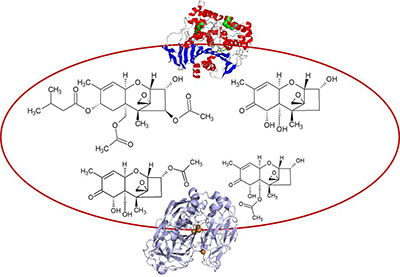
Analytical methods were applied in trichothecenes degradation by enzymatic action resulting in a reduction of 68.4% for DON (deoxynivalenol), 45.4% for 15-ADON (15-acetyldeoxynivalenol), 50.2% for 3-ADON (3-acetyldeoxynivalenol) and 12.3% for T-2 toxin.
https://dx.doi.org/10.21577/0103-5053.20180086
J. Braz. Chem. Soc. 2018, 29(10), 2127-2136
Metal Organic Frameworks for Selective Degradation of Amoxicillin in Biomedical Wastes
Marcos V. Paula; Amanda L. Barros; Kaline A. Wanderley; Gilberto F. de Sá; Marcos Eberlin; Thereza A. Soares; Severino Alves Jr.
How to cite this article
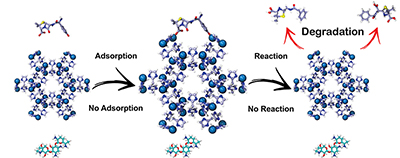
Molecular docking calculations predict the adsorption of widely used antibiotic amoxicillin, but not gentamicin, to the Zn-based metal organic frameworks zeolitic imidazolate framework-8 (ZIF-8) and Zn(1,4-benzenedicarboxylate) (ZnBDC). Mass spectrometry measurements further demonstrate the degradation of amoxicillin upon contact with the Zn-containing frameworks.
https://dx.doi.org/10.21577/0103-5053.20180087
J. Braz. Chem. Soc. 2018, 29(10), 2137-2143
Determination of Estrogens in Milk Using Polypyrrole Fiber-Mediated Solid-Phase Extraction Followed by High Performance Liquid Chromatography
Lanlan Wei; Yan Yan; Jianjun Deng; Yuqin Ma; Yu Wang; Xiaoxiao Wu; Xuejun Kang
How to cite this article
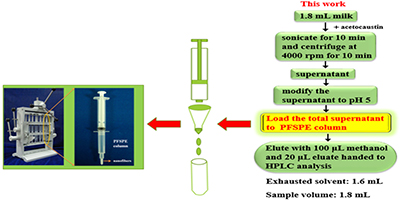
The schematic representation of packed-fiber solid-phase extraction (PFSPE) device and the determination method proposed in this paper.
https://dx.doi.org/10.21577/0103-5053.20180088
J. Braz. Chem. Soc. 2018, 29(10), 2144-2149
Preparation, Characterization and Catalytic Activity of Palladium Catalyst Supported on MgCO3 for Dynamic Kinetic Resolution of Amines
Marina M. M. Ferreira; Camila R. Cabreira; Pedro H. K. Chaves; Gabriela M. Labussiére; Renata C. Zimpeck; Sania M. de Lima; Fernanda A. de Siqueira
How to cite this article

This paper reports the preparation of Pd/MgCO3. The composition and size particle were obtained by X-ray diffraction (XRD) and transmission electron microscopy (TEM), respectively. The catalytic activity was studied for racemization of (S)-(-)-1-phenylethylamine and dynamic kinetic resolution (DKR) of a series of primary amines.
https://dx.doi.org/10.21577/0103-5053.20180089
J. Braz. Chem. Soc. 2018, 29(10), 2150-2157
Multiple-Injection Capillary Zone Electrophoresis as a Fast Strategy to Determine Antinitrosating Capacity of Commercial Teas
Ana P. Ruani; Luciano Vitali; Gustavo A. Micke
How to cite this article

A multiple-injection capillary electrophoresis method was developed to determine antinitrosating capacity of nine commercial teas through nitrite quantification.
https://dx.doi.org/10.21577/0103-5053.20180090
J. Braz. Chem. Soc. 2018, 29(10), 2158-2168
Wax Behavior in Crude Oils by Pour Point Analyses
Lize M. S. L. Oliveira; Rita C. P. Nunes; Ygor L. L. Ribeiro; Dayane M. Coutinho; Débora A. Azevedo; Júlio C. M. Dias; Elizabete F. Lucas
How to cite this article

Two-dimensional gas chromatography of a crude oil sample.
https://dx.doi.org/10.21577/0103-5053.20180092
J. Braz. Chem. Soc. 2018, 29(10), 2169-2179
Effect of Temperature on Devulcanization of Waste Sidewall Rubber by Supercritical Ethanol
Xiang Li; Xiao-Qing Deng; Chao Dong
How to cite this article
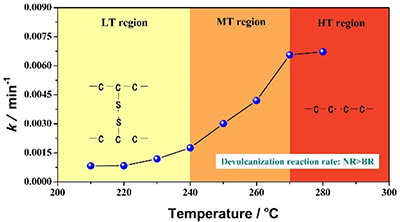
In the low temperature (LT) region, the devulcanization happened due to the breakage of crosslinked bonds. Supercritical ethanol beyond the critical temperatures (medium temperatures (MT) and high temperatures (HT)) could strongly promote the devulcanizing reaction; the breakage of main chains predominated in the devulcanizing process. The devulcanizing reaction rate of natural rubber was faster than that of butadiene rubber.
https://dx.doi.org/10.21577/0103-5053.20180093
J. Braz. Chem. Soc. 2018, 29(10), 2180-2188
Organophosphorus Pesticide in Sapodilla (Manilkara zapota) Fruit
Daniel B. Alcântara; Mario S. O. Paz; Tigressa H. S. Rodrigues; Tatiana S. M. Fernandes; Pablo G. A. Barbosa; Adonay R. Loiola; Patricia Grinberg; Guilherme J. Zocolo; Edy S. de Brito; Ronaldo F. do Nascimento
How to cite this article
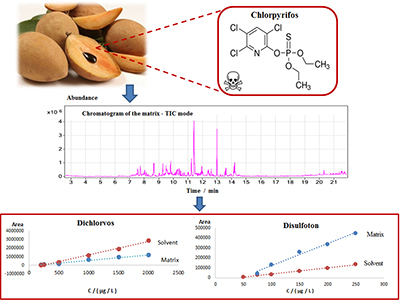
A methodology for the determination of organophosphorus pesticides in sapodilla fruit based on QuEChERS (quick, easy, cheap, effective, rugged, and safe) extraction and gas chromatography-mass spectrometry (GC-MS) detection is described. Strong matrix effects could be observed and was overcome with the use of matrix match calibration. Chlorpyrifos, a level II toxic compound, was found in several commercial samples.
https://dx.doi.org/10.21577/0103-5053.20180094
J. Braz. Chem. Soc. 2018, 29(10), 2189-2196
Use of Constrained Mixture Design in the Optimization of a Method Based on Extraction Induced by Emulsion Breaking for the Determination of Ca, Mg, Mn, Fe and Zn from Palm Oil by Flame Atomic Absorption Spectrometry
Gisseli S. Valasques; Ana M. P. dos Santos; Darllen G. da Silva; Juscelia P. S. Alves; Marcos A. Bezerra
How to cite this article
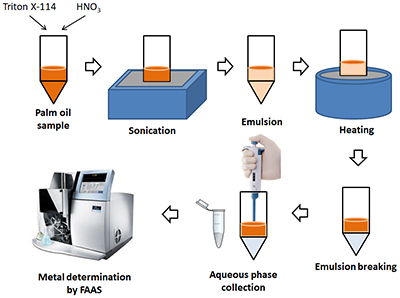
Constrained mixture design was used in the development of a method for Ca, Mg, Mn, Fe and Zn determination from palm oil samples.
https://dx.doi.org/10.21577/0103-5053.20180095
J. Braz. Chem. Soc. 2018, 29(10), 2197-2206
Synthesis, Characterization and Preliminary Study on Acetylpyrazine N(4)Butylthiosemicarbazone as a Potential CDK2 Inhibitor Combined with DFT Calculations
Erna Normaya; Mohammad N. Ahmad; Yang Farina; Ku H. K. Bulat
How to cite this article
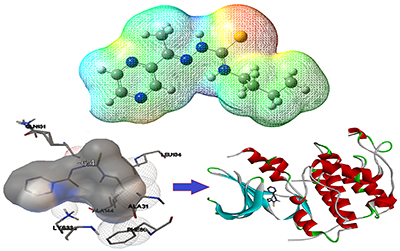
The graphical abstract shows the 3D plots of molecular electrostatic potential of optimized structure and the interaction of acetylpyrazine N(4)butylthiosemicarbazone (APBT) with amino acid residues in cyclin-dependent kinase 2 (CDK2) macromolecule. Calculation within the grid box size of 30 x 30 x 30 Å3 showed the formation of stable complex with binding affinity value of -6.4 kcal mol-1.
https://dx.doi.org/10.21577/0103-5053.20180097
Short Report J. Braz. Chem. Soc. 2018, 29(10), 2207-2212
Degradation Products of Lambda-Cyhalothrin in Aqueous Solution as Determined by SBSE-GC-IT-MS
Renata Colombo; Janete H. Yariwake; Marcos R. V. Lanza
How to cite this article
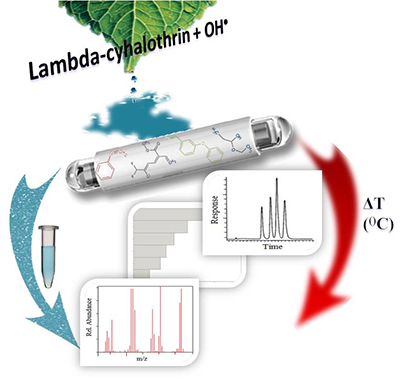
Lambda-cyhalothrin derivative products were identified by stir bar sorptive extraction and gas chromatography using liquid and thermal desorption.
https://dx.doi.org/10.21577/0103-5053.20180096
Online version ISSN 1678-4790 Printed version ISSN 0103-5053
Journal of the Brazilian Chemical Society
JBCS Editorial and Publishing Office
University of Campinas - UNICAMP
13083-970 Campinas-SP, Brazil
Free access










